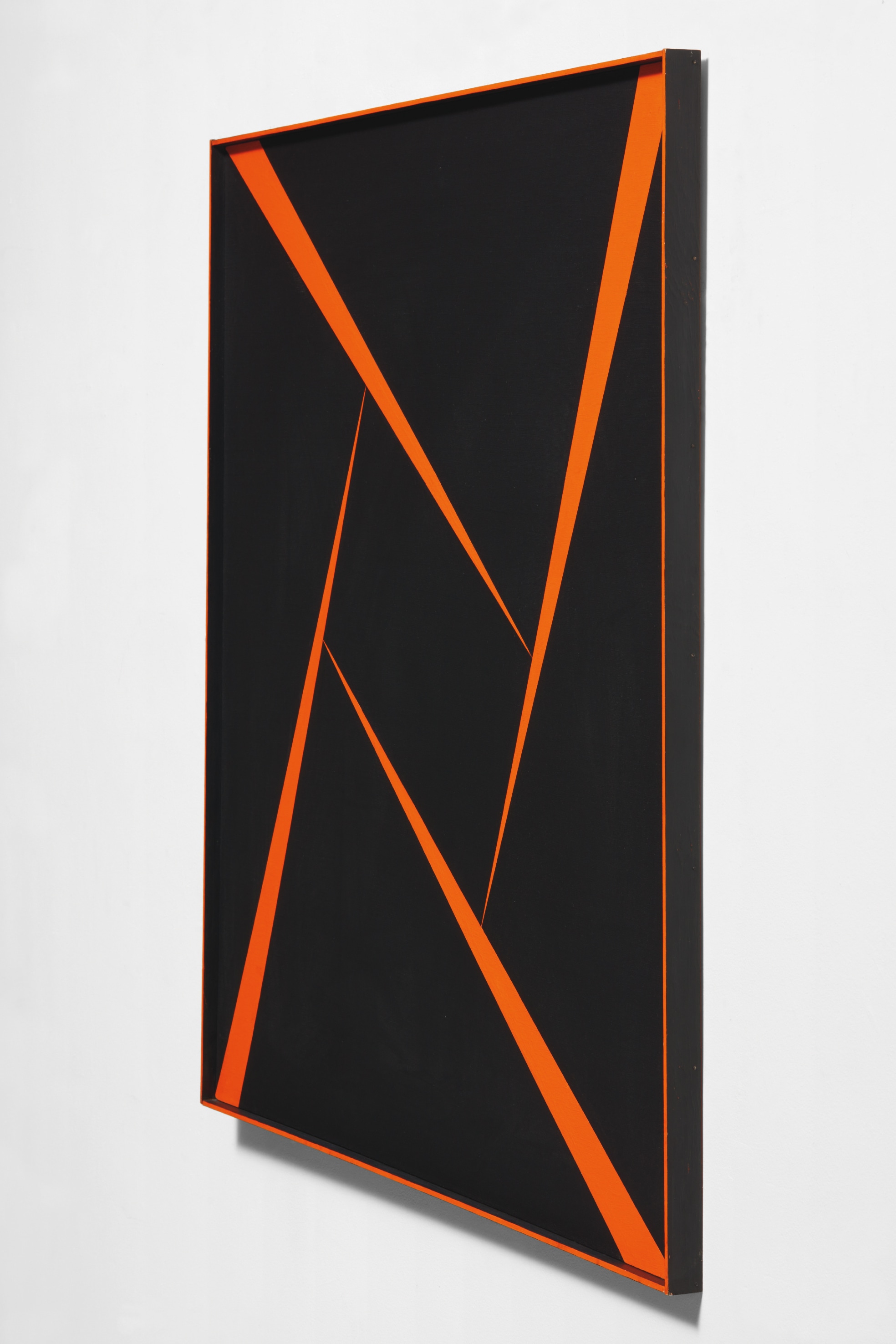



33Ο
Carmen Herrera
Untitled (Orange and Black)
Full-Cataloguing
Painted in 1956, Untitled (Orange and Black) is among the first mature paintings Carmen Herrera created upon returning to New York from Paris two years prior. A remarkable example of the asymmetrical and intuitive arrangement of forms characteristic of her New York period, the dichromatic painting is testament to the modular, almost mathematical process of combining and rotating triangular forms that Herrera initiated in 1956 with works such as this one. As in Green and White, 1956, Herrera has placed four elongated triangles at each corner and oriented them centripetally with their tips pointing inward – here enclosing a rectangular shape at the center. While the interplay of geometry and color results in palpable tension that projects outside the confines of the canvas, the refined flat surface treatment in Untitled (Orange and Black) illustrates Herrera’s goal of focusing the viewer’s attention on the materiality of the work’s support structure. This emphasis on the artwork’s objectness, i.e. its status as an object hanging on a wall, is further achieved by Herrera’s groundbreaking strategy of integrating the frame into the work’s very composition, which Herrera has here painted with the same orange paint used for the triangles. Works such as Untitled (Orange and Black) exemplify how Herrera was breaking ground at the same time as like-minded artists such as Frank Stella and Ellsworth Kelly were taking up similar innovations. Sidelined as a female Cuban immigrant in the male-dominated context of the Abstract Expressionist-dominated New York art world, it is only recently, due in part to her 2016 retrospective at the Whitney Museum of American Art in New York, that Herrera has been accorded her due place within the annals of post-war abstraction.
“Color is the essence of my painting,” Herrera reflected, “What starts to happen to it as you reduce its numbers and come down to two colors, then there is a subtlety, an intensity in the way two colors relate to each other” (Carmen Herrera, quoted in Carmen Herrera: The Black and White Paintings, exh. cat., El Museo del Barrio, New York, 1998, p. 18). Herrera’s abstract practice grew out of a true cross-cultural dialogue within the international history of geometric and Concrete abstraction. In the 1940s, during her first sojourn in New York, Herrera had already been in dialogue with her close friend and Abstract Expressionist painter Barnett Newman about the significance of color within abstraction. “We spoke about the nature of abstraction, its very essence,” Herrera recollects. “Barney felt strongly that abstraction needed a mythological or religious basis; I, on the other hand, wanted something clearer, less romantic and dark” (Carmen Herrera, quoted in Carmen Herrera: The Black and White Paintings, exh. cat., El Museo del Barrio, New York, 1998, p. 18).
Untitled (Orange and Black) was created six years after Herrera’s decisive move towards abstraction upon encountering the Bauhaus and Russian Suprematism when she and her husband moved to Paris in 1948. Color and form cannot be separated in Herrera’s paintings. The delineation of the triangular and rectangular forms in this work demonstrates the structural and compositional significance of color in Herrera’s abstract oeuvre, whereby color and form equally embodies or promotes the significance of the other. The visual execution of such paintings follows an analytical study of the relation between color, shape, and scale, whereby Herrera chooses color instinctively and determines the scale of the canvas only upon finalizing the color and compositional organization on paper. This reliance on color shows strong affinities with the Brazilian Concreto and Neo-Concreto movement, with the resulting dynamism and rhythm in Herrera’s abstraction specifically anticipating Hélio Oiticica’s abstract paintings from the late 1950s. As with Herrera’s greatest works, it is the masterful balance of form and color that gives rise to a powerful stabilizing/destabilizing effect. Utterly captivating in both its grandeur and simplicity, Untitled (Orange and Black) is a powerful example of the pioneering achievements of one of the hitherto most under recognized abstract painters of the past century.
Carmen Herrera
Cuban / American | B. 1915 D. 2022Carmen Herrera is finally receiving long-deserved recognition for her arresting, hard-edge geometric compositions. Born in Cuba in 1915, Herrera has spent most of her life outside the island, permanently settling in New York in the mid-1950s. Herrera was formally trained as an architect at the Universidad de la Habana, and later completed studies at the Art Students League in New York from 1943 to 1945. During this time she became acquainted with key figures of postwar abstraction including Barnett Newman, whose work undoubtedly influenced Herrera's minimalist aesthetic.
Herrera's work is chiefly concerned with formal simplicity and experimentation with bold color. Through the use of sharp lines and stark color contrasts, she creates dynamic and technically sophisticated compositions that reflect movement, balance and symmetry.